These zesty collard greens are amazing. I don’t usually toot my own horn like this, but this time I really mean it. There’s something magical that happens when hearty greens are cooked slowly together with aromatics and cured or smoked meats. This is a great recipe to impress some friends at a BBQ or to cook on a Sunday while tidying up the apartment and making your neighbors jealous with smells. The long cooking time means that most of the effort is in the first 20 minutes and majority of it is super simple chopping and browning.
Now, you know me, so before we get to cooking we have to get to the reasons why this dish is so delicious. It all starts with the meat. I’m usually a fan of trying to figure out satiating vegetarian versions of dishes, and you can certainly create a delicious savory and tender collard green dish with vegetarian ingredients…but it will never compare in depth of flavor to this version that uses two different meats.
Heat (temperature, type) + Time = YumSizzle
Bring On The Meat
For this zesty collard green recipe we use two different kinds of meat, pancetta and uncured ham steak. You don’t have to use two different kinds of meat, the important part of this is the addition of some of our favorite flavor elements. First we’re bringing in the fat, and fat is flavor. Second we’re bringing in the browning. And third we’re bringing in texture.
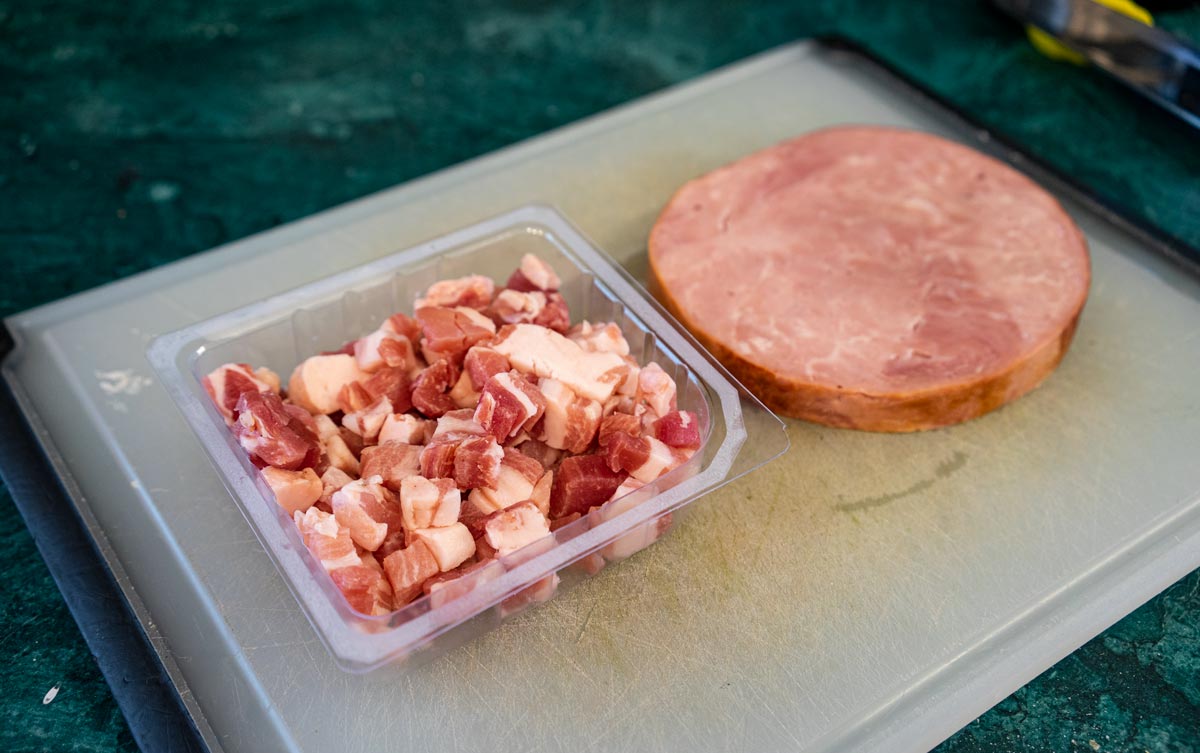
Pancetta
What is pancetta? Well, great question! Pancetta is cured pork belly. There are two preparations of Pancetta. The first preparation (not what we use here) is rolled pancetta. This type of pancetta is often sliced thin and wrapped around foods, used as a baked topping, or served raw in an antipasto or sandwich. The second type of pancetta is flat pancetta, this is what we used today. The flat pancetta is often cubed and used to flavor pasta dishes or cut thick and grilled. Both of these preparations involve curing the meat in a salt brine or rub, then drying the meat for a time depending on how much moisture the manufacturer wants in the meat. The main characteristic differentiating pancetta from the other famous cured pork product (A.K.A. bacon) is that pancetta is not smoked.
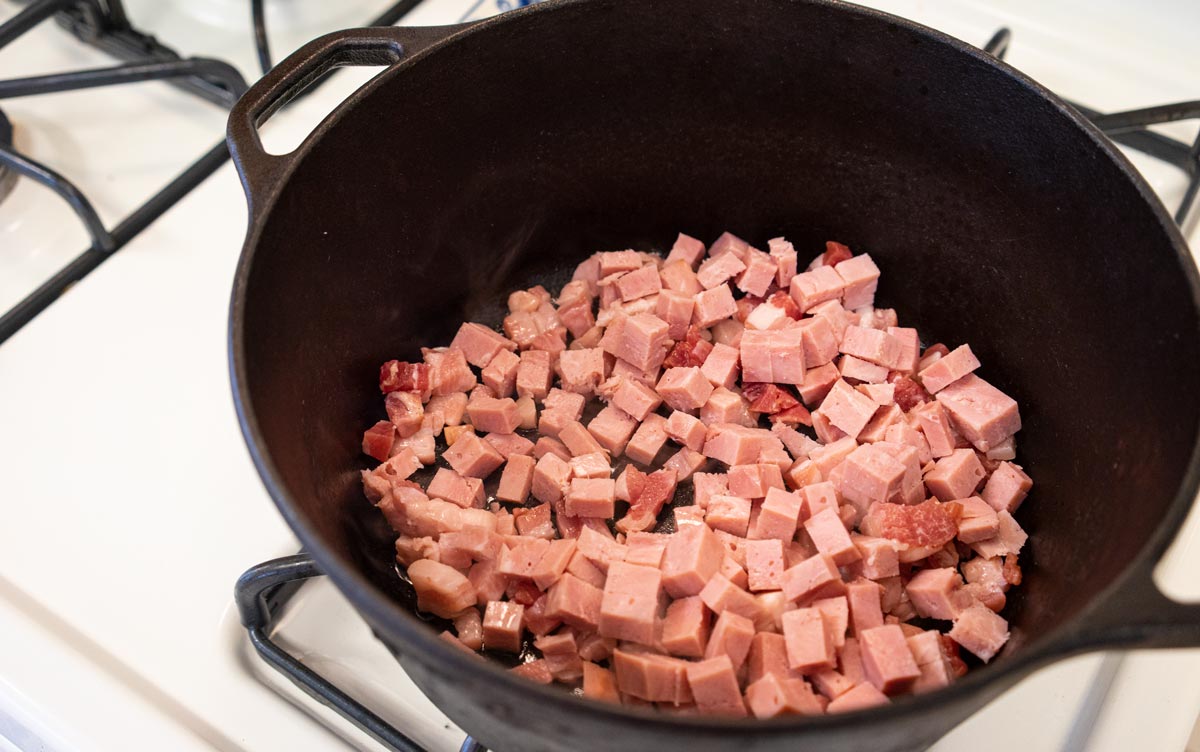
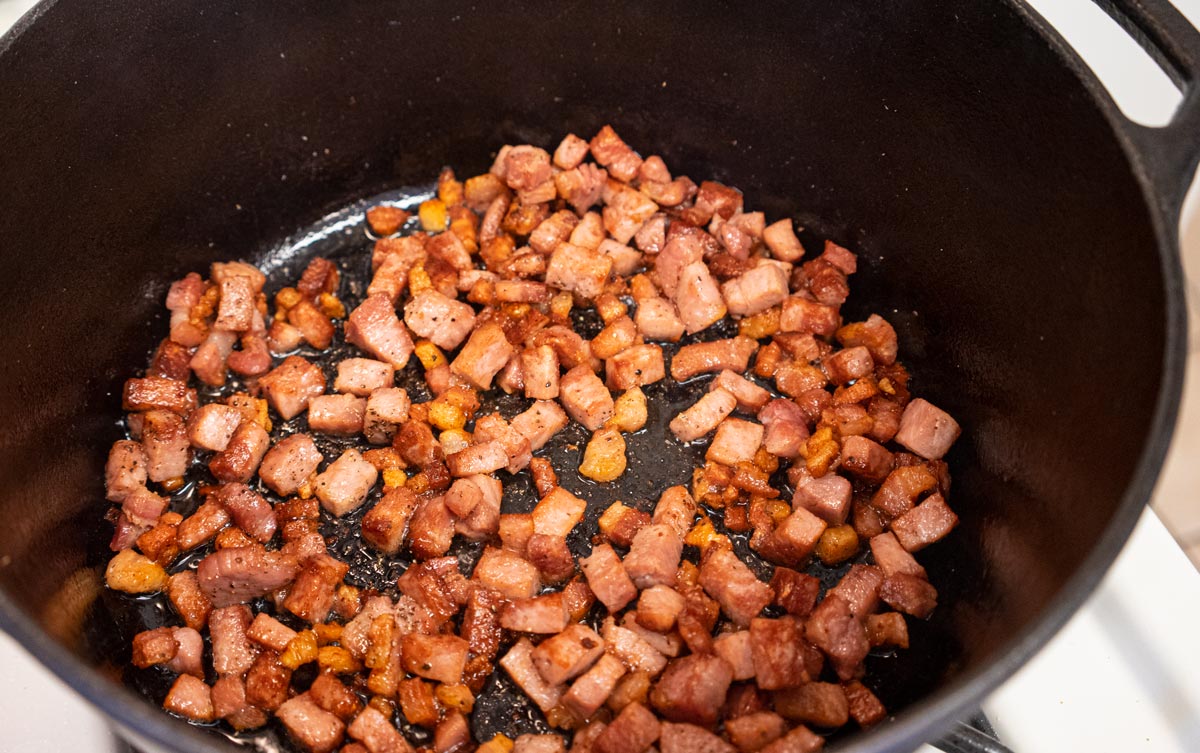
Uncured Ham Steak
Uncured ham steak is a great texture addition to this dish. The uncured in the name just means that there are no additional nitrites added in to the meat, and it’s really just a piece of ham that’s usually already been cooked. Ham steaks come either with the bone or without the bone, I find the most common ham steaks I see are shrink wrapped packed without the bone, that’s what I used in this recipe. The ham steak has way less fat than the Pancetta so it’s going to behave a little differently. Where the pancetta will get super crispy and release a lot of its fat into the pot, the ham steak will brown on the outside and lose water content. That loss of moisture gives us a great texture in the final product as the little cubes of ham still have some chew to them, contrasting the juicy greens and crispy Pancetta.
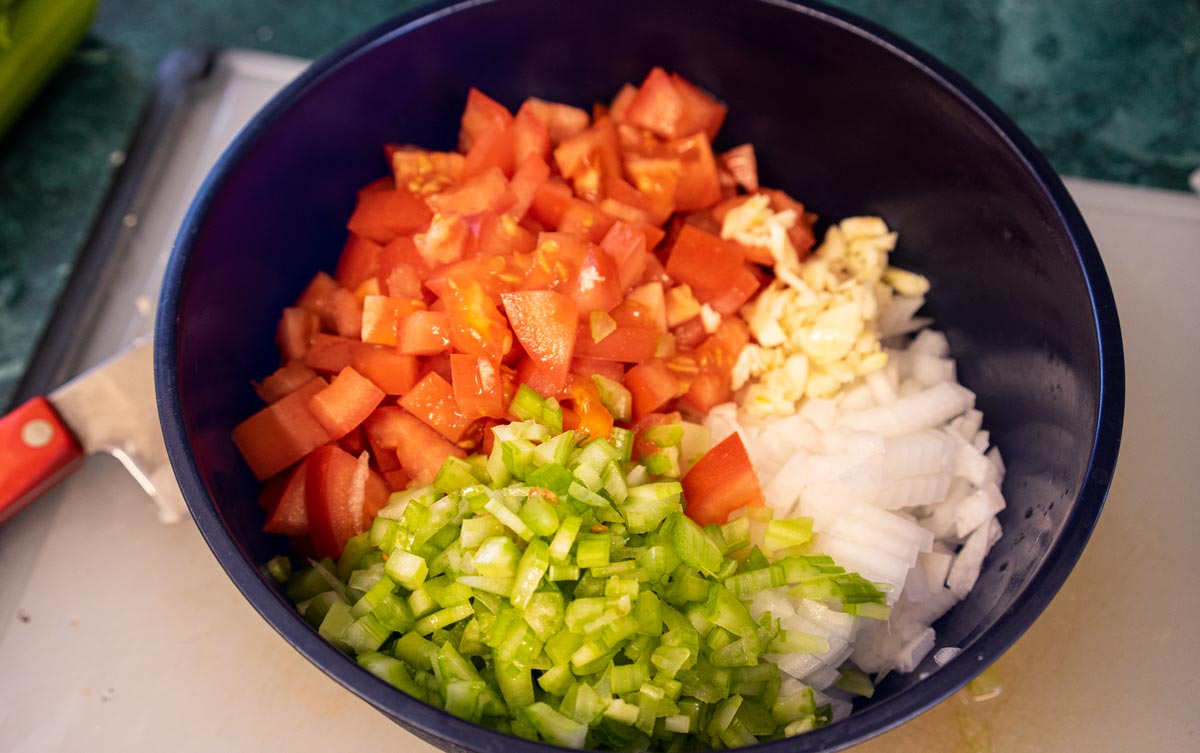
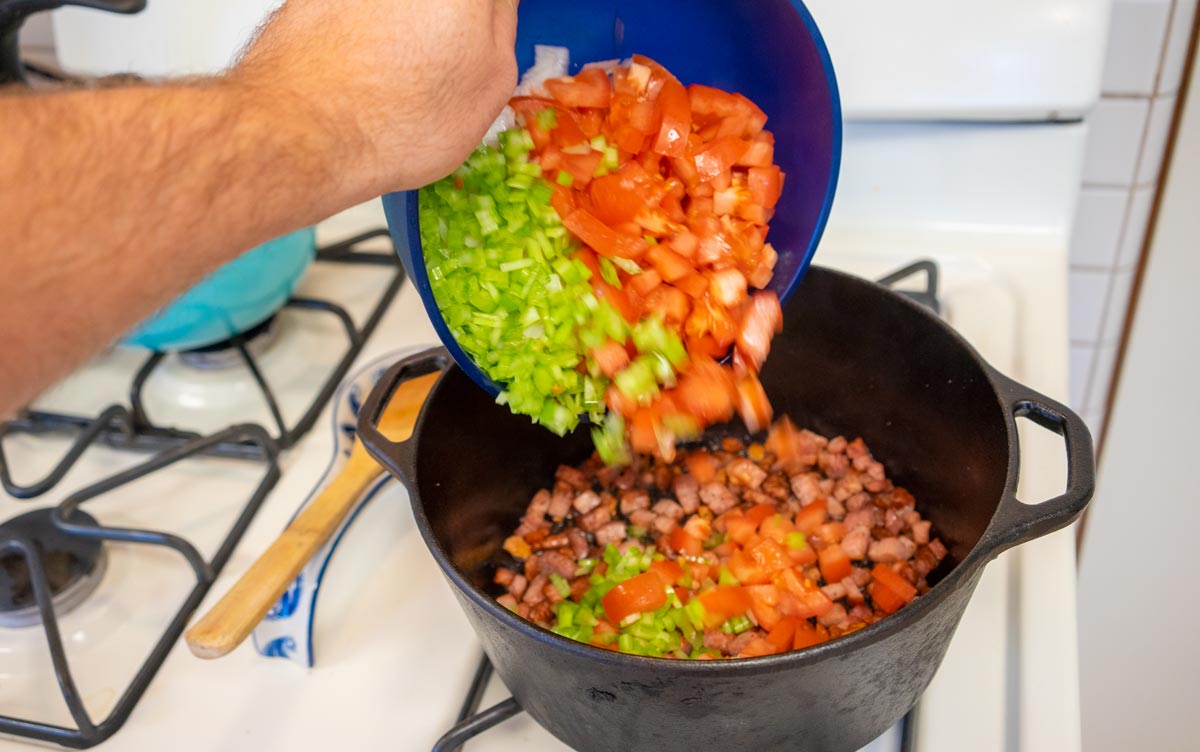
Aromatics Are Life
The base of any great stewed dish is the mixture of aromatics that provide the foundational flavors that the other ingredients build upon. Every culture around the world has their own version of what the key ingredients of this mixture are and these often reflect what’s available regionally. A traditional French Mirepoix is composed of onion, carrot, and celery in a 2:1:1 ratio sauteed in butter. This is the most common base for many Western soups and stews…but there are so many other awesome variations on the theme. Cajun chefs use the ‘holy trinity’ which is a 2:2:1 ratio of onion, celery, and green pepper. Italian chefs might add garlic and parsley into the mix. Chinese chefs would use green onion, ginger, and garlic, whereas a Thai chef would go for basil, lime, and lemongrass.
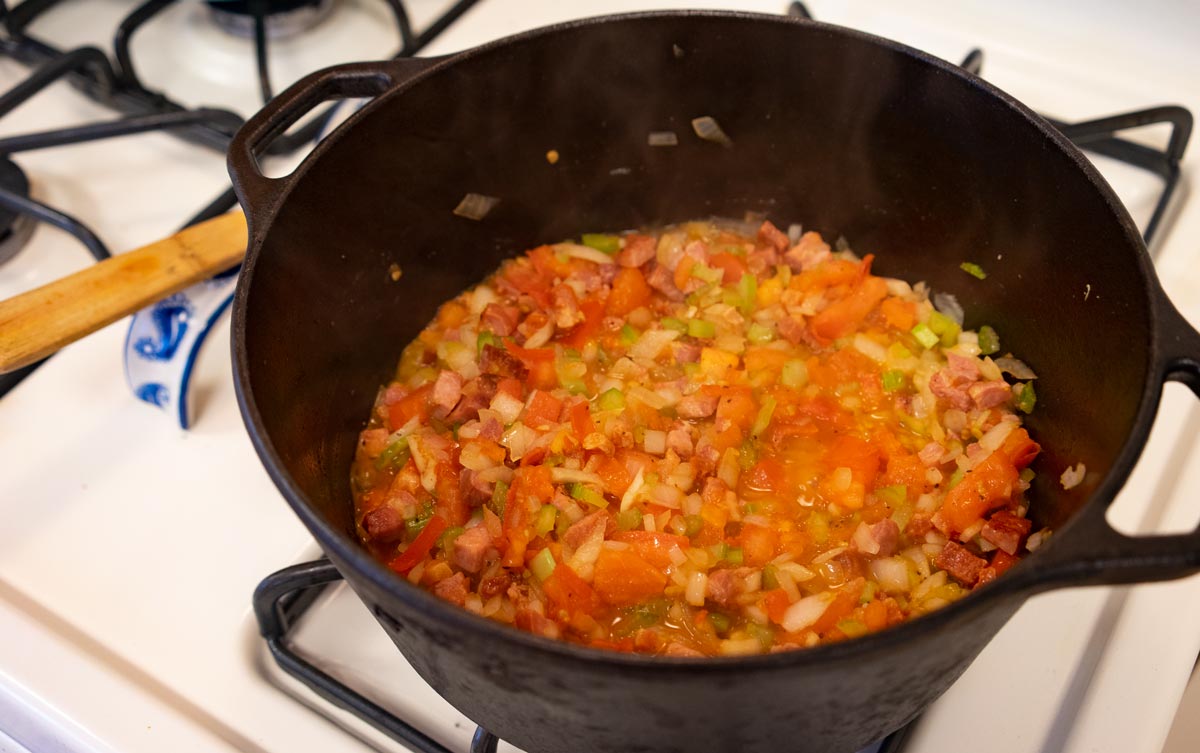
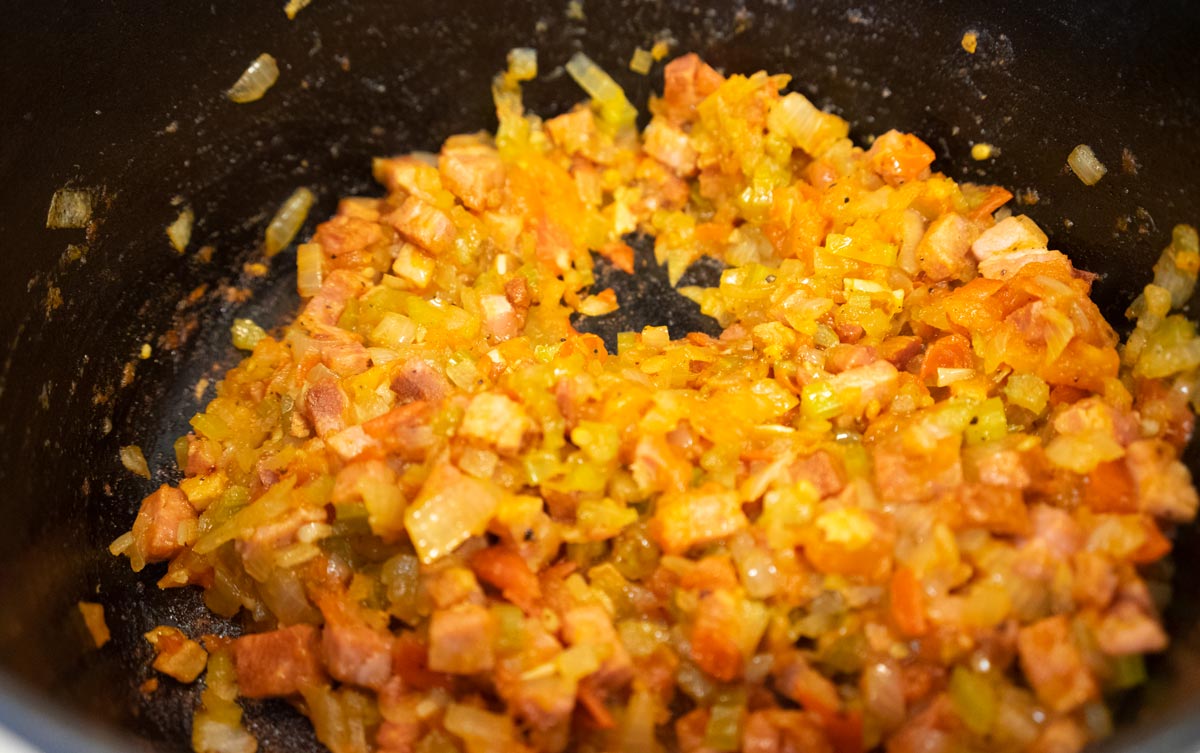
Regardless of what you want to call it, this base mixture of aromatics is the foundation of so many of our favorite foods. It’s also a great way to get experimental in the kitchen and with your recipes without worrying too much about the end result. This recipe for instance uses celery, onion, tomato, and garlic. You could absolutely add in some ginger or bell pepper just to see how it would come out. If you’re making a stock or a stew try substituting or altering the base flavors of the recipe a little bit, you’ll be surprised at the depth you can bring into a dish just by adding in some extra celery or parsley.
Liquid
As with all slow cooked stews or soups the liquid we use plays an important role in what we’re making. In this recipe we use chicken stock because of its fat content and neutral flavor. Chicken stock has an appropriate fat content which serves a couple of purposes. First fat provides a satiating feeling in the mouth which makes dishes taste more luxurious. Second the fat in the broth is a much better vessel for all the delicious flavors we’ve been developing to absorb into. All the enzymatic action and browning we spend time working on with the soffrito and meat will be soaked up into that broth and coat the greens.
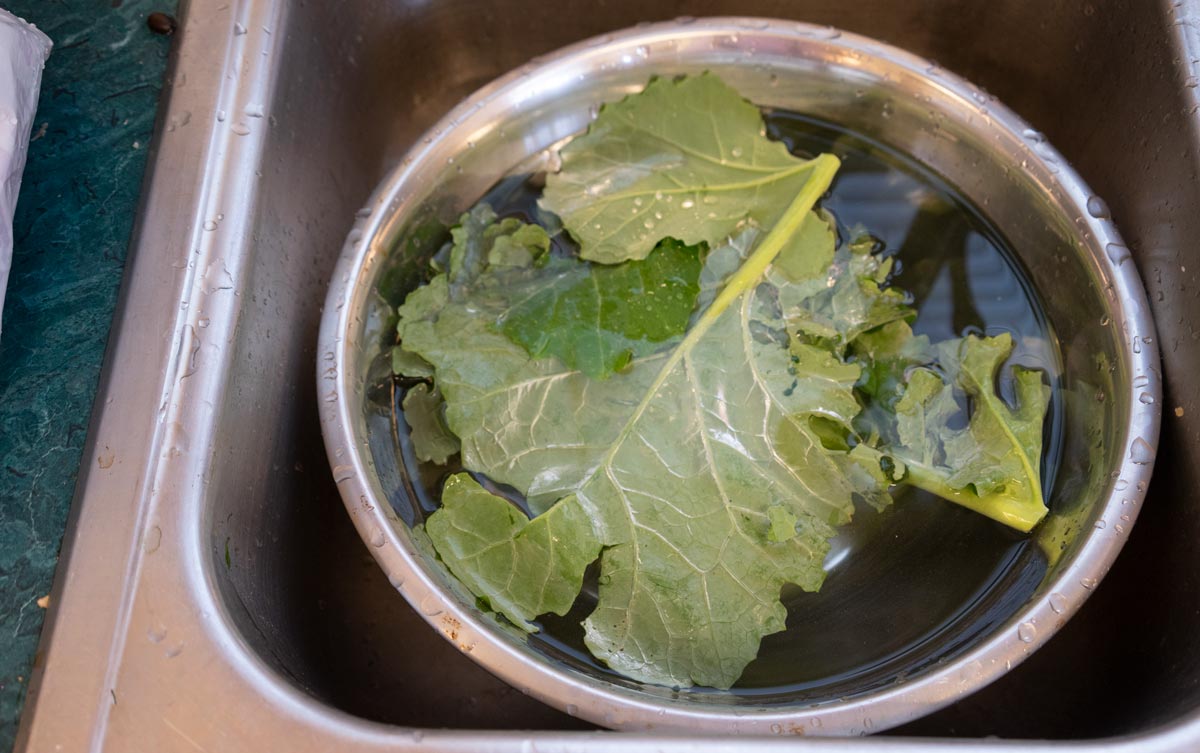
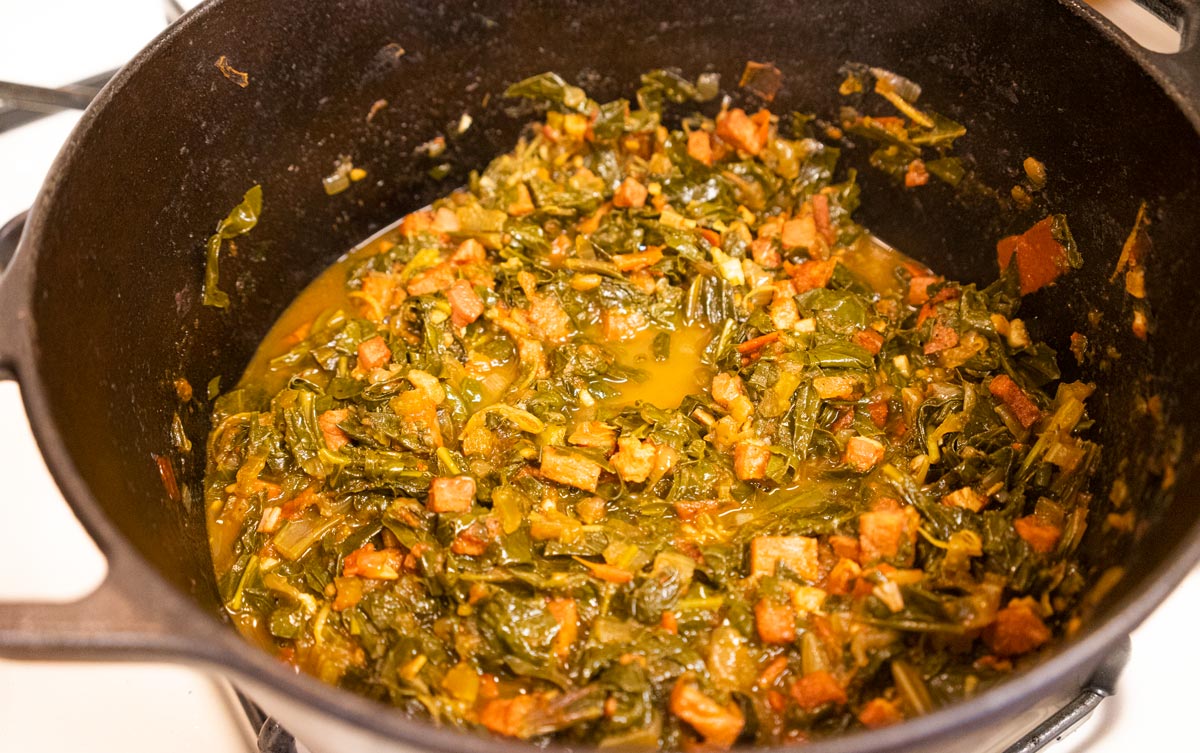
The All Important Greens
Imagine if you made collard greens with lettuce…they would be freaking gross. Ugh, so soggy. Collards (and their brethren the chards and kales of the world) on the other hand are super robust greens that can withstand a longer cooking process. Their stronger cell structures designed to hold in nutrients and withstand the environments they grow best in make them the ideal candidate for this recipe. Collards take up and hold onto more of the mineral materials from the soil they’re grown in, which is one of the reasons why many of the tougher greens have a salty taste to them.
The Secret Ingredient
This is a not so secret secret, but….lemon zest is the hero here. This little addition takes a heavy dish and lifts it up into something you want to eat bowl after bowl of. Often collards are too salty or heavy to have more than a couple bites of. These collards have all the richness you expect, but floating above that buttery mouth coating bite is a zesty lemon brightness.
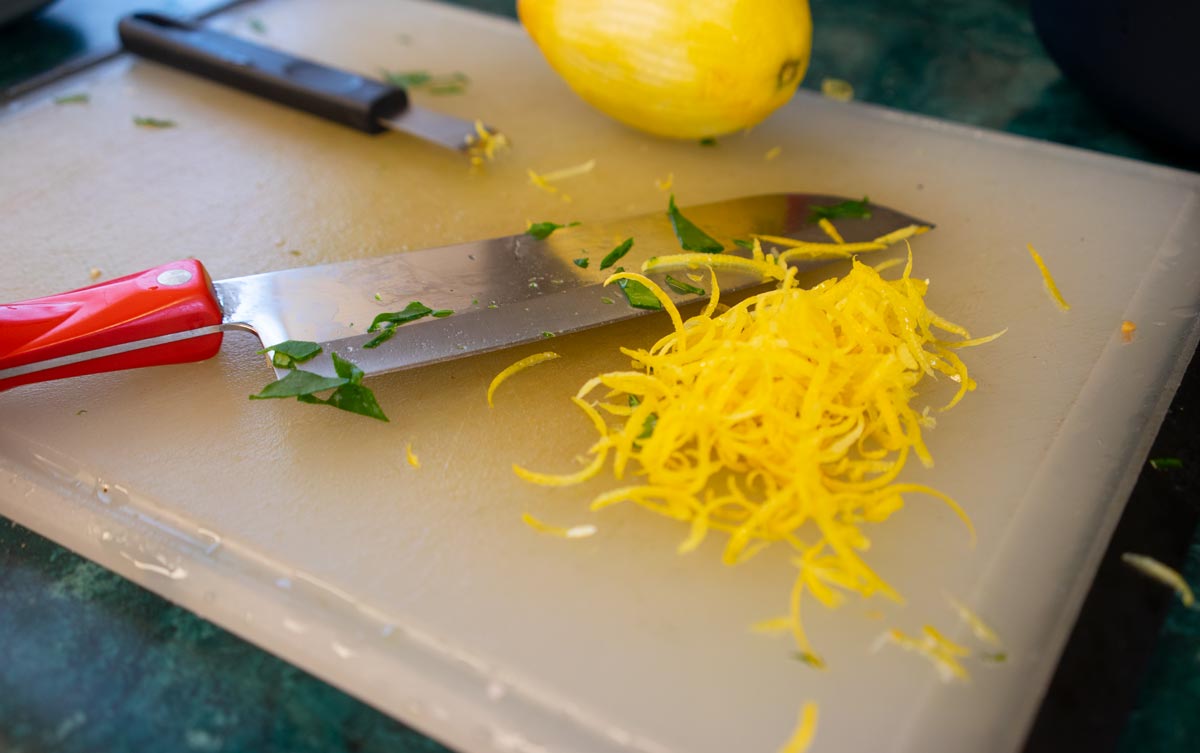
The Final Formula
Let’s break each component down into the Yumsizzle Formula to get a final clear picture of what’s going on here.
Heat (temperature, type) + Time = YumSizzle
The Meat: Cooking the meat at a medium low temperature gives us the crisp fat and brown surfaces we want, while also rendering the fat and water out.
The Aromatics: The soffrito here is being cooked by conduction from the bottom of the pot, and also conduction from the steam escaping the mixture. The lower cooking temperature gives the mixture enough time to release some of its sugars and for the cell structure to break down. After the liquid cooks out those sugars will carmelize on the bottom of the pot and provide body and roundness to the flavor of the stock.
The Greens: By simmering the greens at a low temperature in a convection (yes liquid heat surrounding the food is convection) it will cook evenly and slowly over time. We won’t end up with some cooked pieces and some mushy pieces. It will also gently break down the structure of the greens providing a platform for all those delicious flavors we’ve built up to soak in to.
Zesty Collard Greens
Equipment
- Large thick bottom or cast iron pot with lid
- Cutting Board
- Knife
- Large Bowl
- Wooden Spoon
Ingredients
- 8 oz. Uncured Ham Steak
- 5 oz. Pancetta cubed
- 1 Large White Onion Diced
- 2 Stalks of Celery
- 2 Large Beefsteak Tomatoes Diced
- 3 Cloves of Garlic Minced
- 420 grams Collard Greens 2 bundles(ish)
- 2 cups Chicken Broth or Stock
- ¼ tsp Smoked Paprika
- ⅛ tsp Red Pepper Flakes
- ½ Zest from ½ lemon
- 1 tbsp Unsalted Butter
Instructions
- Set the pot on the stove on medium low heat. Dice the pancetta and ham and add them to the pot. It's going to take 10-15 minutes for those to get nice and crispy. Stir the pork occasionally keeping an eye on it to make sure it isn't burning.
- While the pork is crisping we can prepare our aromatics and get our soffrito variation assembled. Dice the onion, celery, and tomato. Mince the garlic, and place the prepared soffrito ingredients into a bowl.
- After the meat is crisp (10-15 minutes) add in the soffrito (onion, celery, tomato, garlic) and cook on medium low heat stirring occasionally until the liquid is gone, approximately 10 minutes. While the soffrito is cooking down prepare your greens.
- Wash and slice the greens into 1/2 inch wide pieces. Personal preference if you leave the stems or not, some of my greens had little nettles on them so I ended up cutting them off, but for greens like kale, collards, and char I like to use most of the stems.
- When the liquid is gone from the pot, add in the stock and scrape all that deliciousness from the bottom of the pot. Add in the paprika, red pepper flakes, lemon zest, and mix in the greens.
- Turn the heat up to high, bring the mixture to a simmer, then turn the heat down as low as possible and cooke for two hours with a lid partially ajar. Check on the collards every once in a while and give them a stir.
- After 2 hours your greens should be good to go! Add in 1 tbsp. of butter to finish off the dish. Taste at this point and season with salt and pepper to your taste. We got a lot of salt out of the meat and the greens so be careful! If you like your collards less liquidy just take the lid off and reduce the dish for a couple of minutes at a simmer.

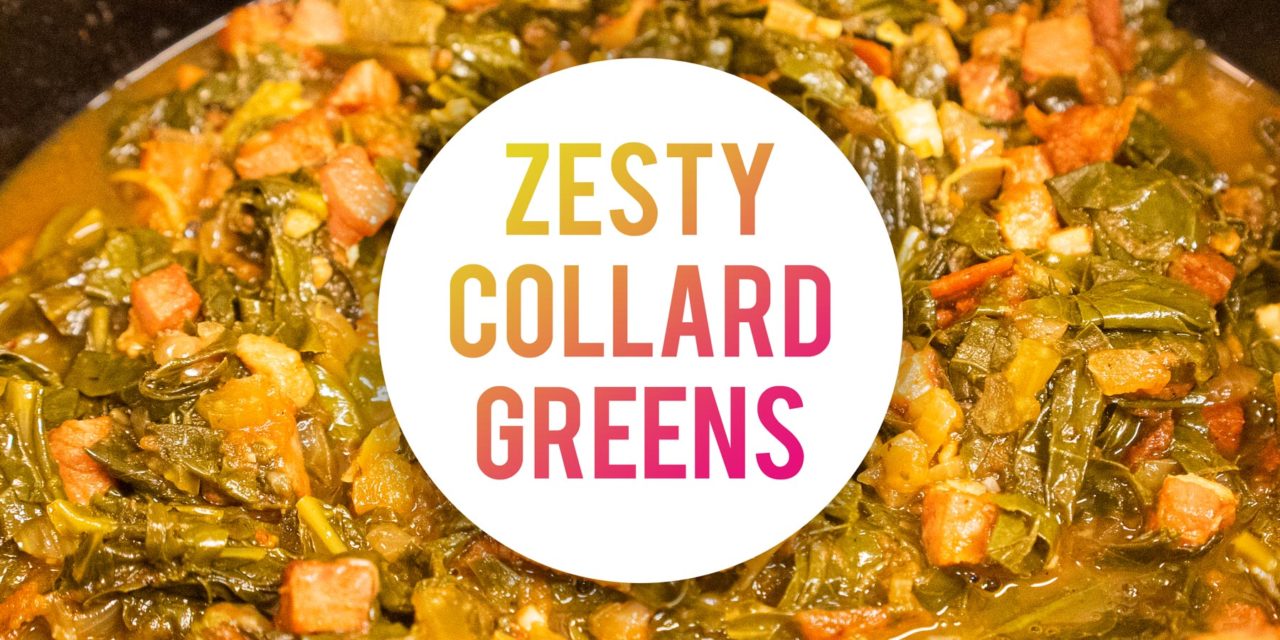

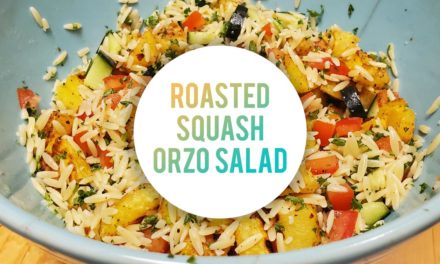

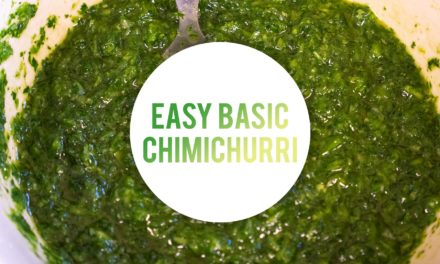
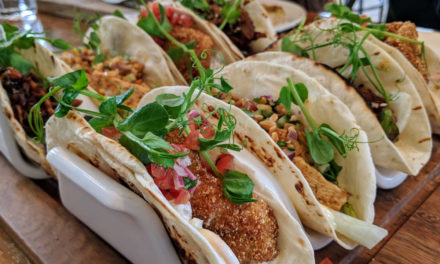





Great content! Super high-quality! Keep it up! 🙂
Thanks! These greens really are delicious, hopefully you enjoyed them too!